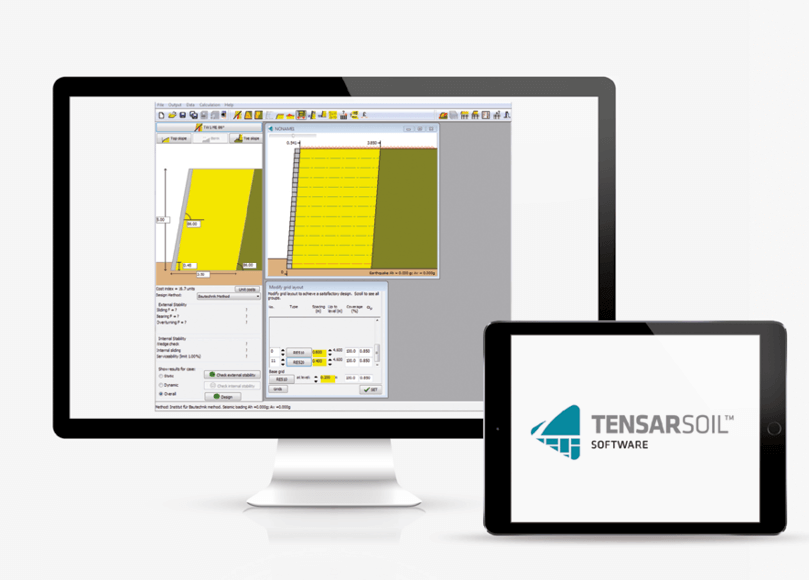Bearing Capacity of Soil - Types and Calculations
Bearing capacity is a basic principle in geotechnical engineering which determines the soil’s ability to support the loads that may be applied to it. Understanding the bearing capacity of soil is crucial for ensuring the safety, stability and cost-effectiveness of construction projects.
The bearing capacity is dependent on a variety of factors including soil type, moisture content, and compaction, as well as other environmental factors. Ultimately, it dictates the maximum load soil can withstand without experiencing shear failure or excessive settlement.
This guide offers an in-depth look at the bearing capacity of soil (also known as ‘ground bearing pressure’), its importance in geotechnical engineering, the various types of soil bearing pressure, and how to calculate it under different conditions.
Use the links below to navigate to the sections you’re most interested in:
- What is the bearing capacity of soil?
- Why is ground bearing pressure important?
- Ultimate and allowable bearing capacity
- The types of soil bearing capacity
- Soil bearing capacity formula
- How to calculate the bearing capacity of soil
- Bearing capacity calculation method
What is the bearing capacity of soil?
Bearing capacity is the capacity of soil to support the loads that are applied to the ground above. It depends primarily on the type of soil, its shear strength and its density. It also depends on the depth of embedment of the load – the deeper it is founded, the greater the bearing capacity.
Where there is insufficient bearing capacity, the ground can be improved or alternatively the load can be spread over a larger area such that the applied stress to the soil is reduced to an acceptable value less than the bearing capacity. This can be achieved with spread foundations composed of reinforced concrete, for example.
In the case of working platforms for cranes and piling rigs, improved load spread is provided by a granular platform whose performance can be further improved by mechanical stabilisation using Tensar geogrids.
Ground Coffee 'Ask Andrew' Episode 4: Andrew Lees explains what bearing capacity means
Why is ground bearing pressure important?
Ground bearing pressure (bearing capacity of soil) is important in construction because whenever a load is placed on the ground, such as from a building foundation, a crane or a type of retaining wall, the ground must have the capacity to support it without excessive settlement or failure.
Calculating the bearing capacity of the underlying soil through a soil bearing capcity test is a vital part of the design phase of any construction project. Failing to understand and account for the ground bearing pressure before beginning the project could have catastrophic consequences, such as a building foundation collapsing at a later stage.
We’ll explore the different methods of soil bearing capacity testing, but first, we’ll look at the differences between ultimate and allowable bearing capacity and the calculations for different soil types.
Ultimate and allowable bearing capacity
There are two main types of bearing capacity of soil: ultimate bearing capacity and allowable bearing capacity. Let’s take a look at the definitions of these terms:
What is the ultimate bearing capacity soil?
The ultimate bearing capacity of soil is the maximum vertical pressure that can be applied to the ground surface before a shear failure mechanism develops in the supporting soil. General, local or punching shear failure may occur, depending on the stiffness and depth of the foundation soil.
In essence, the ultimate soil bearing capacity test identifies the maximum amount of load the soil can take before it fails or gives way completely. This figure isn’t used on its own in the foundation design process, as it’s also important to consider how soil will settle under pressure, which could affect its ability to support a structure.
What is the allowable bearing capacity of soil?
The allowable bearing capacity of soil is the amount of load the soil can take without experiencing shear failure or exceeding the allowable amount of settlement. This is the figure that is used in the design of foundations.
The allowable bearing capacity is always lower than the ultimate bearing pressure because it takes into account the settlement of soil, not just the load required to cause shear failure
Ready to get started with bearing capacity calculations for your next slope design or soil wall project?
Request our free TensarSoil software
The types of soil bearing capacity
There are several more specific types of bearing capacity of soil:
- Ultimate bearing capacity (qᵤ): the maximum vertical pressure that can be applied to the ground surface, at which point a shear failure mechanism develops in the supporting soil.
- Net ultimate bearing capacity (qₙᵤ): the net pressure increase at the foundation base that will result in shear failure of the soil. It is calculated by subtracting the weight of the soil (𝝲) multiplied by the foundation depth (D) from the ultimate bearing capacity (qᵤ). The net ultimate bearing capacity of soil formula is qₙᵤ = qᵤ - 𝝲Df.
- Net safe bearing capacity (qₙₛ): the allowable bearing capacity (qₙₛ) is the net ultimate bearing capacity (qₙᵤ) divided by a factor a safety (typically this will be 3). The net safe bearing capacity of soil formula is qₙₛ = qₙᵤ / F. The factor may be increased to limit settlements further if required.
- Gross safe bearing capacity (qₛ): dividing the ultimate bearing capacity by a factor of safety gives you the gross safe bearing capacity (qₛ = qᵤ / F).
- Net safe settlement pressure (qₙₚ): the maximum load the soil can take before it exceeds the allowable amount of soil settlement.
- Net allowable bearing capacity (qₙₐ): this is the value used in the design of foundations, and is often simply referred to as the ‘allowable bearing capacity’. The net allowable bearing capacity (qₙₐ) is equal to either the net safe bearing capacity (qₙₛ) or the net safe settlement pressure (qₙₚ), whichever is the lower figure.
Soil bearing capacity formula
The general formula for the bearing capacity of soil is qᵤ = c'Nc + γDNγ + 0.5γBNγ. Where qᵤ is the ultimate bearing capacity, c’ is the cohesion of soil, Nc, Nq, and Nγ are bearing capacity factors, D is the footing depth, B is the width of the strip footing, and γ is the unit weight of soil.
To expand on this soil bearing capacity formula further:
- The cohesion of soil is the component of shear strength of a rock or soil that is independent of interparticle friction
- Nc represents the effects of soil cohesion
- Nq depends on the angle of internal friction (ø) of the cohesionless soil
- Nγ = (Nq − 1)tanϕ This formula shows how Nγ, the factor related to the soil's weight, depends on Nq and the soil's internal friction angle (ϕ). The (Nq−1) equation adjusts depending on the difference between the weight of the soil and the pressure above.
You can use this formula to determine ultimate bearing capacity. From that stage, you can follow the steps outlined in the previous section to derive the net allowable bearing capacity (qₙₐ), which is the figure used by design engineers.
How to calculate the bearing capacity of different soil types
Understanding the difference between ultimate and allowable bearing capacity and the formulae involved is crucial, but how do you calculate them? The method depends on the soil type. Let's explore the processes for granular and clay soils.
How to calculate bearing capacity of clay soils
The bearing capacity calculation method depends very much on the soil type. In saturated clays and other fine-grained soils, the incompressible pore water initially supports applied loads, raising the pore water pressure in the soil beneath the applied load. The low permeability of soils like clay means it can take months or years for the pore water to flow, pressures to dissipate, the soil skeleton to compress and the ground surface to settle. This means that clays are generally more vulnerable to bearing capacity failure in the short-term before excess pore water pressures dissipate and effective stress rises.
While the process may sound complex, calculating the short-term bearing capacity in clays is straightforward. This is because a single, uniform value of undrained shear strength is typically assumed, which remains unchanged by the applied load. Although the long-term bearing capacity clays are usually greater and less critical, it can still be calculated using the same method as for sands.
How to calculate bearing capacity of granular soils
The bearing capacity of sands and gravels is typically not a major concern in design, as these soils are relatively strong. Their high permeability allows effective stresses within the soil to increase immediately under the applied load, unlike clay soils, where this process can take months or even years.
Only loose sands with a high water table under a concentrated load (such as a piling rig) may have an issue with bearing capacity. In most cases, settlement governs the design. The calculation of bearing capacity in granular soils such as sands is more complicated because it depends on the effective stress along the assumed failure mechanism, which varies with depth and soil density and due to the applied load itself. Dilatancy in the sand on shearing also complicates matters. When assessing the bearing capacity of soil, it's also important to consider specific soil types like lateritic soils, which are commonly found in tropical regions.
Typical soil bearing capacity values
Here are a few of the typical values you might see for the safe bearing capacity of different soils:
| Soil Type | Safe Bearing Capacity Value (kPa) |
| Soft clay | < 75 |
| Firm clay | 75-100 |
| Loose gravel | < 200 |
| Dense gravel | 200-600 |
These are just a few of the many soils and their safe bearing capacity. The determination of bearing capacity can be a difficult process, however with TensarSoil design software, calculations of bearing capacity can be incredibly easy for all of your geotechnical engineering projects.
Bearing capacity calculation methods
The calculation methods for both soil types are derived from the simplified geometric case of an infinitely long strip load with a vertical load and horizontal ground surface. Various factors can then be introduced to take an approximate account of other shaped loadings (such as rectangular, square, circular), inclined loads and inclined surfaces.
These methods also assume uniform, homogeneous soil conditions. However, a working platform is a good example of a two-layer bearing capacity problem, such as when crane or piling rig loads are applied to the surface of a dense granular layer overlying a weaker subgrade of clay or sand.. Conventional calculation methods cannot be applied here but Tensar has developed the fully validated T-value design method. This takes into account these layered conditions and introduces the benefits of soil stabilisation using Tensar geogrids and geotextiles, like the Tensar Basetex Geotextile, in a scientifically rigorous way.
Soil bearing capacity test methods
Standard Penetration Test (SPT)
The Standard Penetration Test (SPT) is one of the most commonly used methods for assessing soil bearing capacity of fine and coarse-grained soils. However, for clay and gravel, the results are not as reliable. This SPT involves driving a split-barrel sampler into the bottom of a borehole using a series of hammer blows. The N-value is then calculated according to the number of blows required for the sampler to penetrate to a certain depth.
Cone Penetration Test (CPT)
The Cone Penetration Test (CPT) is a dynamic testing method that measures soil resistance to penetration. During the CPT method, a cone-shaped probe is pushed into the ground at a constant rate while the resistance is recorded. The CPT provides a more detailed profile of soil properties and resistance.
Plate Load Test
The Plate Load Test is used to determine the bearing capacity and strength of the ground by applying an increasing load through a circular steel plate. This method induces settlement and the soil’s behaviour is observed under the applied pressure. This soil bearing capacity test method is commonly used when the soil has larger particle sizes or a coarser, firmer texture.
Pressure Meter Test
The Pressure Meter Test is designed to assess the deformation of soil under certain pressures. This test involves inserting a cylindrical probe into a borehole and inflating it to apply pressure to the surrounding soil.
Vane Shear Test
The Vane Shear Test is used to evaluate soft, cohesive soils which have a soil shear strength of up to 0.5 kgf/cm2. This method involves a “vane shear tip” being inserted into a borehole which is then continuously rotated at a constant rate. The shear strength of the soil is then measured according to the torque required to rotate the vane, and the bearing capacity is then calculated.
How Tensar can help
This guide has explained what the bearing capacity of soil is, its importance for geotechnical and structural engineering, the different types of bearing capacity – differentiating ultimate and allowable bearing pressures – and the methods to determine bearing capacity.
As highlighted in the previous sections, calculating the bearing capacity of soil can quickly become complex. To assist you with the calculations involved in the designs for reinforced soil walls, slopes and wall retaining systems and bridge abutments, we have produced our TensarSoil design software (visit this page to request TensarSoil by filling out the form).
Have an upcoming project and require expert support? our design team are here to help.
Get in touch



.png?width=400&height=400&ext=.png)